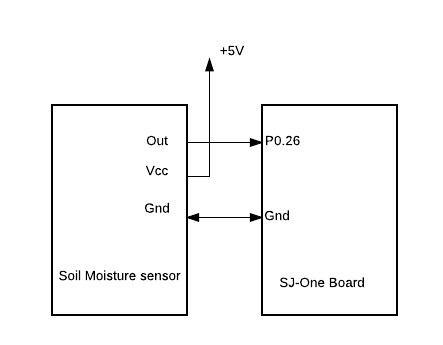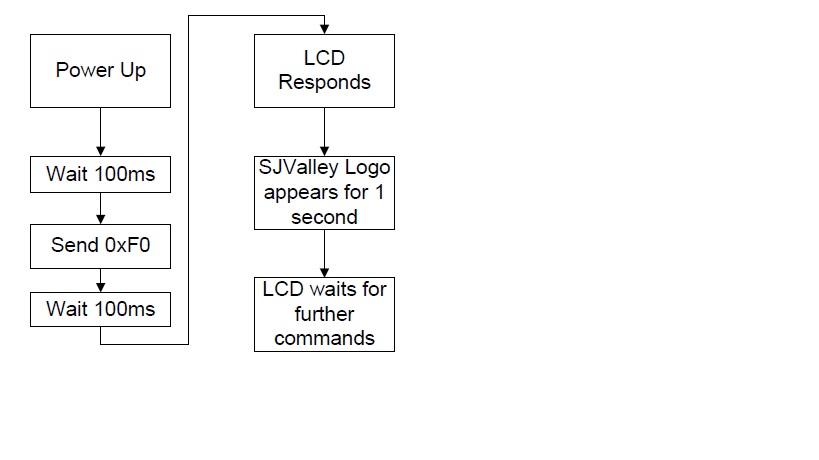Difference between revisions of "S17: Smart Planter"
Proj user9 (talk | contribs) (→Soil Moisture Sensor) |
Proj user9 (talk | contribs) (→Soil Moisture Sensor) |
||
| Line 234: | Line 234: | ||
=='''Soil Moisture Sensor''' == | =='''Soil Moisture Sensor''' == | ||
| − | This soil moisture sensor can read the amount of moisture present in the soil surrounding it. It uses the two probes to pass current through the soil, and then it reads that resistance to get the moisture level. More water makes the soil conduct electricity more easily (less resistance), while dry soil conducts electricity poorly (more resistance). It outputs an Analog signal. It is a simple, 5-volt dc collector, emitter follower output monitoring the soil resistance as a base drive of the emitter follower. The more moisture the lower the base resistance and the more base current. Therefore, the more moisture the greater the emitter follower output voltage 0 to approx. 3.3 volts max. This output pin is connected to P0.26 pin of SJ-One board. The pin is configured as an ADC pin. The analog output from the soil moisture sensor is converted to digital signal via ADC of SJ-One board. If the moisture content is below a threshold a DC pump is turned on which waters the plant. [[File:Moisture. | + | This soil moisture sensor can read the amount of moisture present in the soil surrounding it. It uses the two probes to pass current through the soil, and then it reads that resistance to get the moisture level. More water makes the soil conduct electricity more easily (less resistance), while dry soil conducts electricity poorly (more resistance). It outputs an Analog signal. It is a simple, 5-volt dc collector, emitter follower output monitoring the soil resistance as a base drive of the emitter follower. The more moisture the lower the base resistance and the more base current. Therefore, the more moisture the greater the emitter follower output voltage 0 to approx. 3.3 volts max. This output pin is connected to P0.26 pin of SJ-One board. The pin is configured as an ADC pin. The analog output from the soil moisture sensor is converted to digital signal via ADC of SJ-One board. If the moisture content is below a threshold a DC pump is turned on which waters the plant. [[File:Moisture.jpeg]] |
== Light Sensor == | == Light Sensor == | ||
Revision as of 15:47, 25 May 2017
Contents
Smart Planter
Abstract
This project aims at developing an automatic irrigation and lighting system for plants. An Android app allows a user to remotely monitor and manually control the watering and lighting for the plant.
Objectives & Introduction
The SJOne board sends sensor readings to an Android app through a server. The Android app can also send commands to the SJOne board through the server (such as turning the water pump on or off).
An Android Things app runs on a Raspberry Pi 3 to provide Internet connectivity to the SJOne board and to get timestamps of when the plant was last watered (future enhancements can include more useful features with APIs from Google). The two boards communicate over UART.
Team Members & Responsibilities
- Sona Bhasin
- Johnny Nigh
- Android app
- Server application
- Android Things app
- Communication between the SJOne and Android Things app
- Thrishna Palissery
- Hugo Quiroz
Schedule
| Week # | Start Date | End Date | Task | Status | Actual Completion Date |
|---|---|---|---|---|---|
| 1 | 03/14/2017 | 03/21/2017 |
|
Completed | 03/23/2017 |
| 2 | 03/24/2017 | 04/04/2017 |
|
Completed | 04/06/2017 |
| 3 | 04/04/2017 | 04/14/2017 |
|
Completed | 04/15/2017 |
| 4 | 04/04/2017 | 04/11/2017 |
|
Completed | 04/10/2017 |
| 5 | 04/11/2017 | 04/28/2017 |
|
Completed | 04/22/2017 |
| 6 | 04/11/2017 | 04/25/2017 |
|
Completed | 04/25/2017 |
| 7 | 04/11/2017 | 04/28/2017 |
|
Completed | 05/05/2017 |
| 8 | 04/18/2017 | 04/30/2017 |
|
Completed | 04/30/2017 |
| 9 | 04/20/2017 | 05/05/2017 |
|
Completed | 04/28/2017 |
| 10 | 05/06/2017 | 05/10/2017 |
|
Completed | 05/12/2017 |
| 11 | 05/10/2017 | 05/15/2017 |
|
Completed | 5/19/2017 |
| 12 | 05/11/2017 | 05/21/2017 |
|
Completed | 5/25/2017 |
Parts List & Cost
| Item # | Description | Distributor | Qty | Cost |
|---|---|---|---|---|
| 1 | SJOne Board | 1 | $80 | |
| 2 | Soil Moisture sensor | Amazon | 1 | $5.99 |
| 3 | Light sensor | Amazon | 1 | $8.99 |
| 4 | Rain sensor | ebay | 1 | $1.99 |
| 5 | Temperature and Humidity sensor | Amazon | 1 | $7.99/4 pieces |
| 6 | DC water pump | Amazon | 1 | $12.99 |
| 7 | Flow meter | Amazon | 1 | $10.99 |
| 8 | Raspberry Pi 3 | Amazon | 1 | $36.78 |
| 9 | Voltage regulator (3.3V) | Sparkfun Amazon | 1 | $1.95 |
| 10 | Voltage regulator (5V) | Amazon | 1 | $7.99/12 pieces |
| 11 | LCD display (20x4) | Amazon | 1 | $32.10 |
| 12 | Lamp | ? | 1 | $ |
| Total: $207.76 |
Design & Implementation
The design section can go over your hardware and software design. Organize this section using sub-sections that go over your design and implementation.
Hardware Design
Discuss your hardware design here. Show detailed schematics, and the interface here.
Hardware Interface
In this section, you can describe how your hardware communicates, such as which BUSes used. You can discuss your driver implementation here, such that the Software Design section is isolated to talk about high level workings rather than inner working of your project.
Soil Moisture Sensor
This soil moisture sensor can read the amount of moisture present in the soil surrounding it. It uses the two probes to pass current through the soil, and then it reads that resistance to get the moisture level. More water makes the soil conduct electricity more easily (less resistance), while dry soil conducts electricity poorly (more resistance). It outputs an Analog signal. It is a simple, 5-volt dc collector, emitter follower output monitoring the soil resistance as a base drive of the emitter follower. The more moisture the lower the base resistance and the more base current. Therefore, the more moisture the greater the emitter follower output voltage 0 to approx. 3.3 volts max. This output pin is connected to P0.26 pin of SJ-One board. The pin is configured as an ADC pin. The analog output from the soil moisture sensor is converted to digital signal via ADC of SJ-One board. If the moisture content is below a threshold a DC pump is turned on which waters the plant. 
Light Sensor
The light sensor is used to detect the current ambient light. The light sensor which is used in this project uses a photo resistor. It changes its resistance based on the amount of light that falls upon it. The light sensor produces an analog output voltage in the range of 0-4v max. This analog output is connected to the pin P1.31 of SJ-One board which is configured as ADC. Since the SJ-One pins can tolerate only a max of 3.3v, the output from the light sensor is stepped down to 3.3 v using a voltage divider. The stepped down voltage is then given as the input to the ADC pin. The light sensor requires 5V supply voltage. If the amount of light falls below a threshold a lamp is turned on.File:Light.jpg
LCD
The Liquid Crystal Display used for this project was NHD-0420D3Z-NSW-BBW-V3. This display uses a built-in PIC16F690 for serial communication. It can work in different modes (I2C, SPI, RS232/UART). RS232/UART was used for this project as communication. To enter the RS-232 mode, both R1 and R2 on LCD should be open. A 5v voltage supply is provided. The pin P0.0 of SJ-One board is used as the TX 3 (UART3) pin. This pin is connected to the RX pin of LCD display. The baud rate used for communication was 9600. The communication format is 1 Start bit, 8-bit data, 1 Stop bit, no parity, no hand-shaking.
Software Design
Show your software design. For example, if you are designing an MP3 Player, show the tasks that you are using, and what they are doing at a high level. Do not show the details of the code. For example, do not show exact code, but you may show psuedocode and fragments of code. Keep in mind that you are showing DESIGN of your software, not the inner workings of it.
Implementation
This section includes implementation, but again, not the details, just the high level. For example, you can list the steps it takes to communicate over a sensor, or the steps needed to write a page of memory onto SPI Flash. You can include sub-sections for each of your component implementation.
Testing & Technical Challenges
Describe the challenges of your project. What advise would you give yourself or someone else if your project can be started from scratch again? Make a smooth transition to testing section and described what it took to test your project.
Include sub-sections that list out a problem and solution, such as:
My Issue #1
Discuss the issue and resolution.
Conclusion
Conclude your project here. You can recap your testing and problems. You should address the "so what" part here to indicate what you ultimately learnt from this project. How has this project increased your knowledge?
Project Video
Project Source Code
References
Acknowledgement
I (Johnny Nigh) would like to thank Michael Nigh for his help with setting up the server and help with the basics on the Socket.IO JavaScript library.
References Used
- Android Things - Getting Started with the SDK Preview
- Android Things - Samples - UART Loopback
- Hoisington, Corinne. Android Boot Camp for Developers Using Java: A Guide to Creating Your First Android Apps. Boston, MA: Cengage Learning, 2016.
- Hardy, Brian; Marsicano, Kristin; Phillips, Bill; Steward, Chris. Android Programming: The Big Nerd Ranch Guide, Edition 2. Atlanta, GA: Big Nerd Ranch, LLC. 2015.
Appendix
Future enhancements:
- Automatically get the timezone based on the location of the board that is running the Android Things app (using the Google Maps Timezone API).
- Add push notifications.
- I.e. a soft watchdog in the SJOne application can tell the Android Things app to alert the user (if a possible failure has been detected).
- Add support to turn watering and lighting on or off through voice commands (using the Google Assistant SDK).